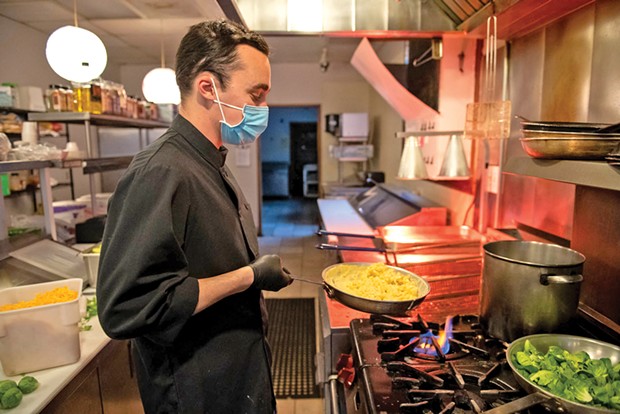Night Shift
New Americana's one-man mission
By Jennifer Fumiko Cahill [email protected] @jfumikocahill[
{
"name": "Top Stories Video Pair",
"insertPoint": "7",
"component": "17087298",
"parentWrapperClass": "fdn-ads-inline-content-block",
"requiredCountToDisplay": "1"
}
]
Since November, when the crew at Chuchi's Old Town Eats takes off their aprons and heads out at 5 p.m., Seth Pate has been starting his shift. He's been running New Americana, a separate nighttime delivery restaurant, out of the kitchen where once he cooked for the former Masaki's Kyoto Restaurant, prepping and cooking its comfort food-heavy menu for customers largely ordering off DoorDash and Uber Eats.
Pate's rental agreement, under which he pays a fraction of what he would have for his own kitchen, is up at the end of the month, so he's on the hunt for a place of his own. He's looking at the move as a chance to expand, to see if his solo operation, which has him turning out orders until 11 p.m. seven days a week, can scale up with more space, more staff and maybe a new subscription model. But he'll need to carry the operation alone for at least a little while longer.
Pate has roughed it before. After moving from Sonora, he says he spent his first three months at Humboldt State University living out of a sedan, parking in a campus lot overnight, studying at the library and showering at the gym until he found housing. "Me and my buddy had little camp stoves cooking on the back of our cars ... it's not impossible to do but it's profoundly uncomfortable." As for what they cooked, he recalls "an awful lot of beans and rice, oatmeal in Mason jars."
It was around then he got a job dishwashing, followed by gigs as a barista, a bartender and a cook. By the time he finished his economics degree, Pate says he had a solid foundation in the restaurant business, too.
The menu he developed for New Americana is "cravings" focused, ranging from Italian-inspired fried polenta sticks with marinara sauce to grilled Japanese shishito peppers and panko-crusted chicken sandwiches, with the biggest seller being the Midnight Moon Manchego Mac. All of it's geared for transport and heat retention, unlike, say, French fries, which can go soggy even with the best to-go containers and insulated bags. Pate briefly considered offering storable frozen items but some informal social media polling showed there was more local demand for "easy at-home family meals."
While the kitchen closes at 11 p.m., Pate says between clean-up and prep for the following day, he doesn't leave until 1:30 or 2 a.m. "It sounds kind of insane because it is," Pate says, admitting he doesn't know how long he can keep it up. "The only way I'm able to maintain my sanity at this point is to have a heavily regimented schedule. ... Literally the day revolves around sleeping, exercise, walking my dog and going back to work at the restaurant." With a laugh he says, "I would much prefer living in my car at this point."
On a given night, Pate says he might turn out anywhere from 10 to 35 orders with an average check size around $25. There is no order minimum, and DoorDash and Uber Eats take 25 to 30 percent cuts of the profits. "I'm definitely earning a larger margin than a conventional restaurant [with no employees and reduced rent] but ... I haven't worked it out, but I'm probably earning less than minimum wage." It's worth it to him in the short-run to prove the concept can work if he scales up with a higher volume of sales to cover the cost of staff and overhead.
"This industry is being destroyed and it necessitates innovation," says Pate, making the pitch for the subscription model he sees a couple of restaurants in San Francisco trying out. Subscribers have meals delivered in reusable containers marked with a QR code and return them when they get their next order. These setups, he explains, cut down both waste and costs over time, and make it easier to gauge demand and plan inventory. But unlike those kitchens outsourcing the necessary software, delivery and container services, he'd like to do it all in-house. That would likely take time and outside investors.
"I would love to be able to do dine-in, there's a lot of benefits to that," Pate says, including added tab-boosting items like alcohol and desserts, but he doesn't see enough customers eager to sit down at a restaurant anytime soon. When indoor dining eventually comes back, he thinks a to-go subscription service could strengthen a conventional dine-in restaurant, allowing it to sell beyond occupancy caps while not worrying about filling the room every night. "I think a lot of restaurants will have to transition to this model if they are going to sustain themselves as mom and pops."
A subscription service, according to Pate, would also need a more nutritionally balanced rotating menu. But that's down the road — right now he's looking at spaces like the former Marcelli's restaurant and figuring out whether he can realize his plans from its tiny, time-worn kitchen. Then it's back to the burners at 5 p.m. to cook the things his customers, homebound by the pandemic, want on a winter evening: a hand-dipped corn dog, a fried chicken sandwich and lots of macaroni and cheese.
Jennifer Fumiko Cahill (she/her) is the arts and features editor at the Journal. Reach her at 442-1400, extension 320, or [email protected]. Follow her on Twitter @JFumikoCahill.
more from the author
-
Eco Cemeteries, Flags, Impacts and Foods
- Apr 12, 2024
-
Sunken Seaweed's Dual Mission
Stocking shelves and the ocean with seaweed and kelp
- Apr 11, 2024
-
Alternative Energy Brainstorming with Billionaires
- Apr 11, 2024
- More »

































